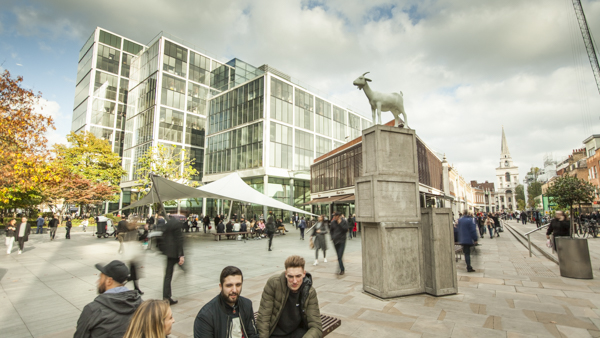Time lapse video explained? If you want to find out exactly how we do it read on...
Time lapse is the most basic form of film making. Stitching together hundreds or thousands of individual photographs to create one piece of footage. In fact we need 25 individual photographs to make one second of footage.
"Time-lapse photography is a technique whereby the frequency at which film frames are captured (the frame rate) is much lower than that used to view the sequence. When played at normal speed, time appears to be moving faster and thus lapsing. For example, an image of a scene may be captured once every second, then played back at 25 frames per second; the result is an apparent 25 times speed increase". Wikipedia
Hopefully the following will make things clearer?
IF YOU NEED SOME ADVICE PLEASE CALL US ON 0203 362 8288


THE FOUR STAGES OF TIME LAPSE VIDEO PRODUCTION
1. Pre-production
- Site assessment visit and induction.
- Agree camera positions.
- Submit RAMS.
- Prepare relevant equipment.
- Send approved script to the voiceover artist for recording.
- Compile approved titles and logos.
- Select appropriate music.
2. Installation and Execution
- Install the cameras in the pre-determined positions.
- Test and instigate recording
- If required we can move or add cameras as the project progresses.
- We can shoot progress photography.
- We can shoot video and supply drones to film key stages of the project to compliment the time lapse footage in the final edit.
3. Post-production
- Remove all equipment from site.
- Process the thousands of image files and then 'stick' them together to form time lapse sequences.
- Select the 'key' footage from these time lapse sequences, removing all the uninteresting and unusable footage.
- Editing-combine this footage with the voiceover, titles, logos and music to form the "rough-cut" edit. This is posted securely on line for all stakeholders to review.
4. Delivery
- We act on your feedback, creating the final edit in the format requested (wmv. mov. mp4. etc).
- Upload or embed the your films within your web site and social media platforms.
- We can host the high definition video for you, ensuring that your customers always see the very best high definition quality.
- Check out our PORTFOLIO
THE SIX STAGES OF TIME LAPSE VIDEO CREATION
Step 1. Which File format?
The choice is RAW or JPEG. What is the difference?
RAW file
- Uncompressed and contains huge amounts of information/detail.
- Can be heavily manipulated during post-production to enhance the image.
- Produces the best image quality possible which can be processed up to 4K and 6K
- It can't be used straight from the camera. It has to be processed with imaging software.
JPEG file
- Compressed and contains acceptable amounts of information/detail.
- Cannot be heavily manipulated during software processing
- Produces a very good image quality.
- Can be used straight from the camera.
Step 2. Camera Positioning
The brief will describe what action needs to be documented and we can help determine the best positions for the cameras to be located.
Ideally you don't want to shoot into the sun and if possible, some shelter from the elements would be favourable.
During manned camera operation in public spaces, it is advisable to consider passing foot traffic and ensure that the camera cannot be accidentally moved.
It is essential that the camera is fixed securely, so it does not move between exposures. We have a wide variety of fixings and supports available.
Step 3. Framing & Composition
This is a crucial element of the process as the final footage is a different format (16:9) to that of the original photograph (3:2). It is therefore essential that we allow for this difference when composing a photograph. The easiest way to do this is to change the camera setting from the Stills setting to Movie Mode, this will crop the image to 16:9 on the viewing screen. We can then frame our composition accurately.
We compose the photograph making sure we include the key elements required as briefed by the client.
We allow for the progression and expansion of the construction process. If we are documenting a tower block construction it will eventually grow vertically, so we have to allow for this in the initial composition.
Step 4. Focusing and Exposure Settings
It is critical that the Autofocus facility on the camera is switched off. If not, the movement of workmen or plant within the shot will cause the lens to continually re-focus, rendering the resulting footage unusable as there will be a noticeable difference between each separate frame.
With the lens is set to manual and the correct focus set, we lock the lens focus ring to prevent any movement during the recording.
Ideally both the aperture and shutter speed settings should be set manually to avoid and image 'flickering' within the final video footage.
Step 5. Programming the Camera and Recording
We now have to tell the camera how often we want it to take a photograph. For this we use an Intervalometer. This crucial device tells the camera when to fire the shutter release- i.e every 1 second or maybe every 5 minutes?
It is either a built in facility within the camera or bought as a separate item which plugs into the camera.
The skill here is to estimate the best interval which will illustrate the action in the most informative and entertaining manner.
We assess the action within the shot i.e people, plant movement, construction processes etc and set the intervalometer accordingly.
Step 6. File Processing and Editing
The hundreds or thousands of image files that we have shot now require processing. This includes cropping, enhancing the visual appearance and de-flickering any exposure changes.
We use two programmes, Adobe Lightroom and LRTimelapse for processing and stitching the images together.
The resulting time lapse sequences can then be edited to form our final video
